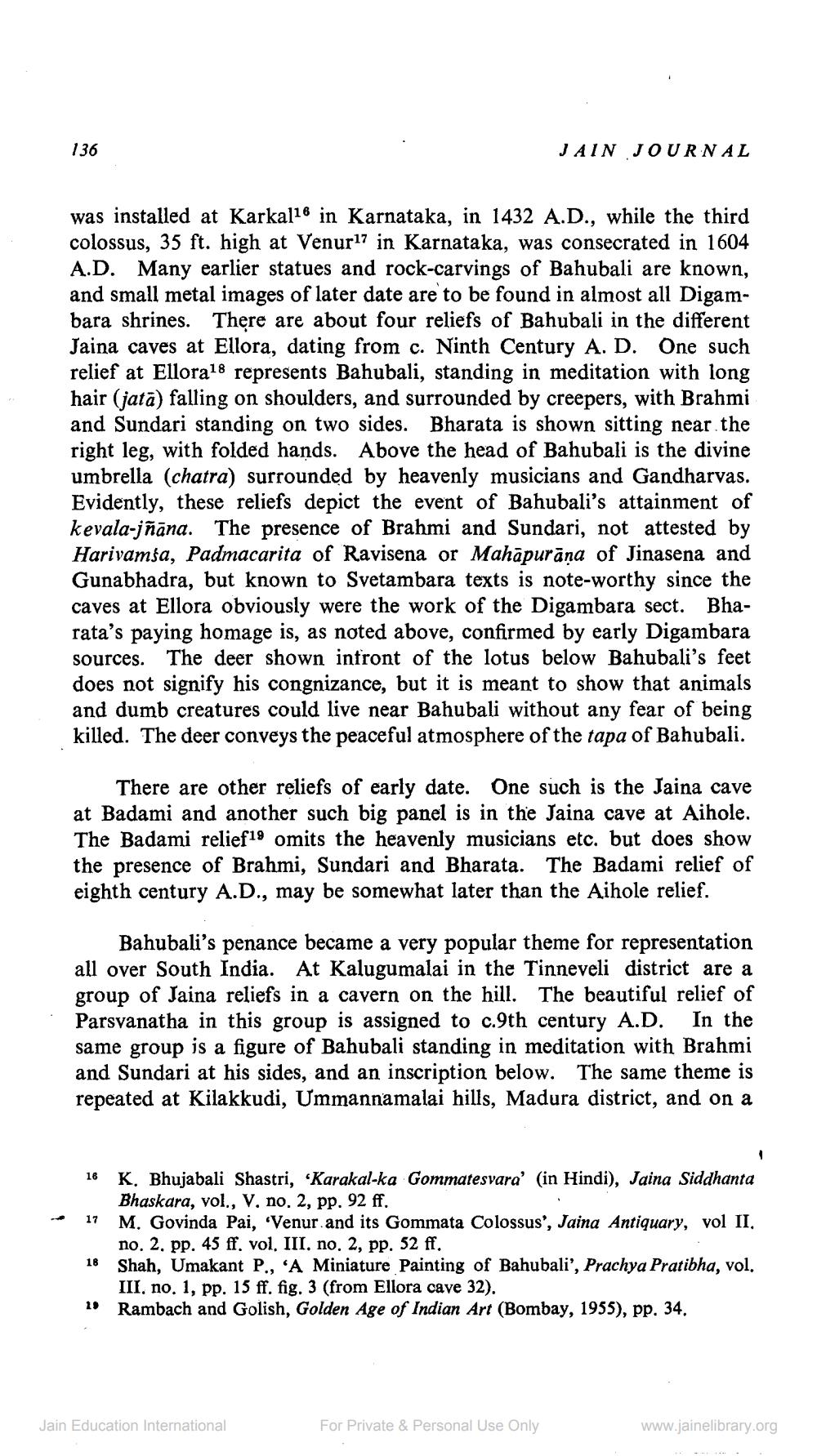________________
136
JAIN JOURNAL
was installed at Karkal16 in Karnataka, in 1432 A.D., while the third colossus, 35 ft. high at Venur17 in Karnataka, was consecrated in 1604 A.D. Many earlier statues and rock-carvings of Bahubali are known, and small metal images of later date are to be found in almost all Digambara shrines. There are about four reliefs of Bahubali in the different Jaina caves at Ellora, dating from c. Ninth Century A. D. One such relief at Ellora18 represents Bahubali, standing in meditation with long hair (jata) falling on shoulders, and surrounded by creepers, with Brahmi and Sundari standing on two sides. Bharata is shown sitting near the right leg, with folded hands. Above the head of Bahubali is the divine umbrella (chatra) surrounded by heavenly musicians and Gandharvas. Evidently, these reliefs depict the event of Bahubali's attainment of kevala-jñāna. The presence of Brahmi and Sundari, not attested by Harivamsa, Padmacarita of Ravisena or Mahāpurāna of Jinasena and Gunabhadra, but known to Svetambara texts is note-worthy since the caves at Ellora obviously were the work of the Digambara sect. Bharata's paying homage is, as noted above, confirmed by early Digambara sources. The deer shown infront of the lotus below Bahubali's feet does not signify his congnizance, but it is meant to show that animals and dumb creatures could live near Bahubali without any fear of being killed. The deer conveys the peaceful atmosphere of the tapa of Bahubali.
There are other reliefs of early date. One such is the Jaina cave at Badami and another such big panel is in the Jaina cave at Aihole. The Badami relief19 omits the heavenly musicians etc. but does show the presence of Brahmi, Sundari and Bharata. The Badami relief of eighth century A.D., may be somewhat later than the Aihole relief.
Bahubali's penance became a very popular theme for representation all over South India. At Kalugumalai in the Tinneveli district are a group of Jaina reliefs in a cavern on the hill. The beautiful relief of Parsvanatha in this group is assigned to c.9th century A.D. In the same group is a figure of Bahubali standing in meditation with Brahmi and Sundari at his sides, and an inscription below. The same theme is repeated at Kilakkudi, Ummannamalai hills, Madura district, and on a
16
17
K, Bhujabali Shastri, Karakal-ka Gommatesvara' (in Hindi), Jaina Siddhanta Bhaskara, vol., V, no. 2, pp. 92 ff. M. Govinda Pai, "Venur. and its Gommata Colossus', Jaina Antiquary, vol II. no. 2. pp. 45 ff. vol. III, no. 2, pp. 52 ff. Shah, Umakant P., 'A Miniature Painting of Bahubali', Prachya Pratibha, vol. III, no. 1, pp. 15 ff. fig. 3 (from Ellora cave 32). Rambach and Golish, Golden Age of Indian Art (Bombay, 1955), pp. 34.
18
Jain Education International
For Private & Personal Use Only
www.jainelibrary.org




